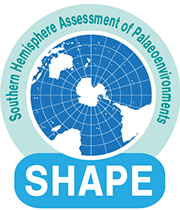INQUA IFG 1608F Southern Hemisphere Assessment of Palaeo-Environments (SHAPE)

SHAPE follows on from the AUS-INTIMATE initiative. This new project will start in 2013 and continue until next INQUA meeting in Dublin in 2019. SHAPE will continue some of the goals of AUS-INTIMATE such as the production of high resolution palaeoclimate records during the late Quaternary. However, it will have a wider spatial scope, incorporating New Zealand, Australia, the Pacific Islands, South America, South Africa, Antarctica and the Southern Ocean.
SHAPE sits under, and will provide information on the Southern Hemisphere to the INQUA International Focus Group CELL-50K (Calibrating Environmental Leads and Lags over the last 50ka) and ACER (Abrupt Climate Changes and Environmental Responses). Thus the time scale of focus has also extended back to 50-60 ka (the limit of radiocarbon dating).
Expertise and assembly of proxy data for different SH sub-regions will be underpinned by existing and new INTIMATE ‘groups’. The work within each SH sub-region will be coordinated by steering committee members (see Table below), who will also be responsible for the exchange of information during hemisphere-wide integrations.
The main objectives of SHAPE are:
- defensible chronologies for SH proxy records
- refine and extend regional climate event stratigraphies
- provide robust interpretations of proxies (qualitative and quantitative)
- generate regional reconstructions of past environmental and climatic change (temporal-geographic syntheses)
- integrate the results into a hemispheric-wide story for key time slices, highlighting the changes and testing hypotheses for their causes
- the integration of proxies with climate model simulations
Suites of quantitative and qualitative marine and terrestrial climate reconstructions will be compiled to provide transects from the tropics to the mid and high-latitudes. These will allow detailed regional reconstructions of currents, fronts and temperature gradients. Like the goals of AUS-INTIMATE, the SHAPE project will highlight the timing of critical changes, and identify synchronous vs. asynchronous changes in climate.
However, unlike INTIMATE there will be a larger focus on using these proxy based reconstructions to compare with climate model simulations to determine distinct circulation and climate modes of the past. SHAPE will aim to reconstruct atmospheric and oceanic circulation patterns for several critical periods in the Late Quaternary (32ka, 21ka, 6ka) to improve our understanding Southern Hemisphere (SH) climate and environmental changes. These reconstructions will be compared to the PMIP3 (Paleoclimate Modelling Intercomparison Project) and CMIP5 multi-model ensemble for these same time periods and a transient simulation for the last 8 ka. Integration with climate model simulations will also help us to formulate new hypotheses about triggers of climate change, climate dynamics, and mechanisms of inter-hemispheric climate teleconnections.
We encourage you to come along to the SHAPE meetings and workshops over the next few years. SHAPE welcomes participation from early career as well as established Quaternary researchers. There is a small amount of financial support for early career researchers to attend SHAPE meetings.
Training will be a key SHAPE activity. It will focus on using new tools designed for palaeoclimate research. We will utilize the Past Interpretation of Climate Tool (PICT), currently under development to generate targets for SH circulation patterns based on Australasian data, and other areas of the SH to assist in interpreting hydroclimatic and circulation conditions linked to a wide array of climate drivers. Proxy reconstructions and understanding of local responses to circulation changes, will also help improve the interpretation of proxy data.
Please contact Andrew Lorrey (a.lorrey@niwa.co.nz), Steven Phipps (s.phipps@unsw.edu.au), Brian Chase (brian.chase@um2.fr) of Maisa Rojas (maisa@dgf.uchile.cl) for further details about the project, or contact steering committee members to get involved in your region.
| Name | Institution | Steering committee |
| Jessica Reeves | University of Ballarat | Australian |
| Lynda Petherick (ECR) | Queensland University of Technology | Australian |
| Peter Almond | Lincoln University | New Zealand |
| Marcus Vandergoes | GNS Science | New Zealand |
| Matthew Prebble (ECR) | ANU | Pacific Islands |
| Michael Shawn Fletcher (ECR) | Melbourne University | Multi-region Liaison |
| Chris Moy (ECR) | Otago University | Multi-region Liaison |
| Patricio Moreno | Universidad de Chile | South American |
| Maisa Rojas | Universidad de Chile | South American and climate modelling |
| Brian Chase | Institute des Sciences de l’Evolution de Montpelier | South Africa |
| Mike Meadows | University of Cape Town | South Africa |
| Helen Bostock | National Institute of Water and Atmospheric Research (NIWA) | Oceans |
| Giuseppe Cortese | GNS Science | Oceans |
| Tas Van Ommen | Australian Antarctic Division | Antarctica |
| Joel Pedro | Univeristy of Tasmania | Antarctica |
| Duncan Ackerley | Monash University | Climate modelling |
| Anthony Kiem | Newcastle University | Proxy calibration |